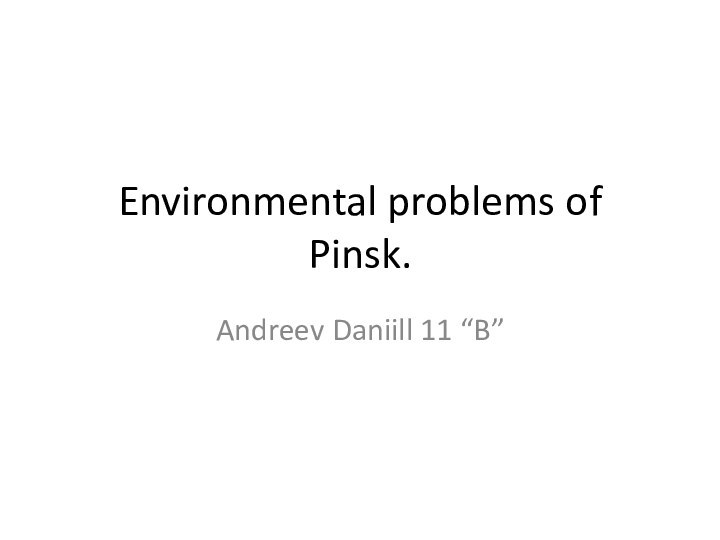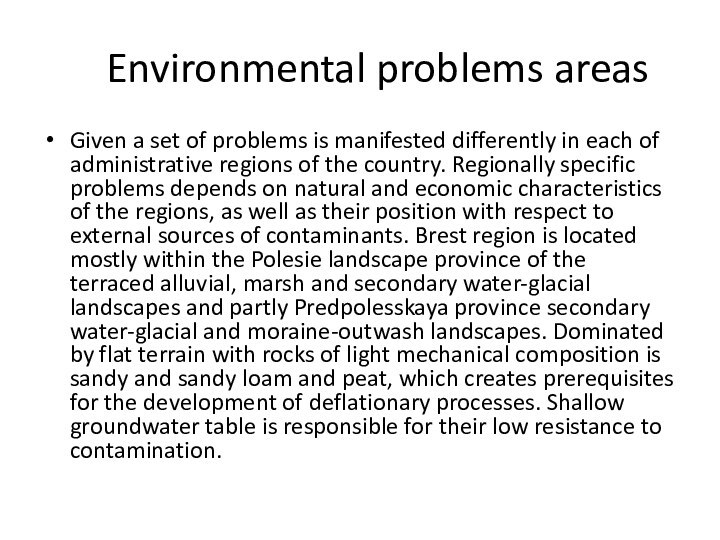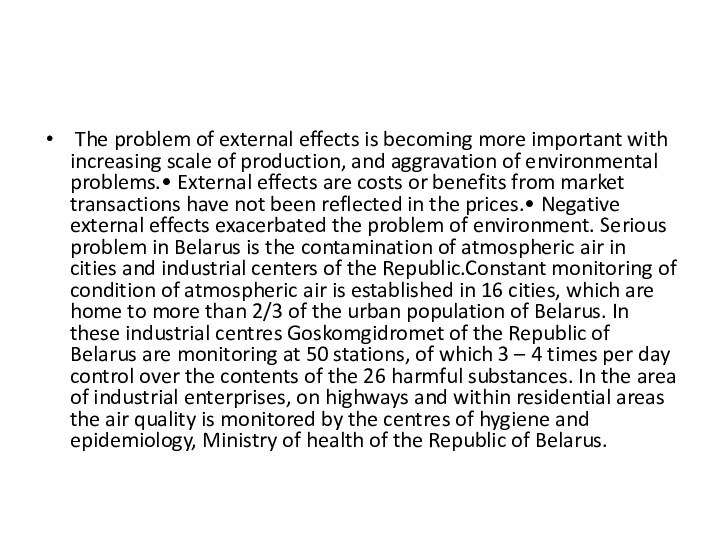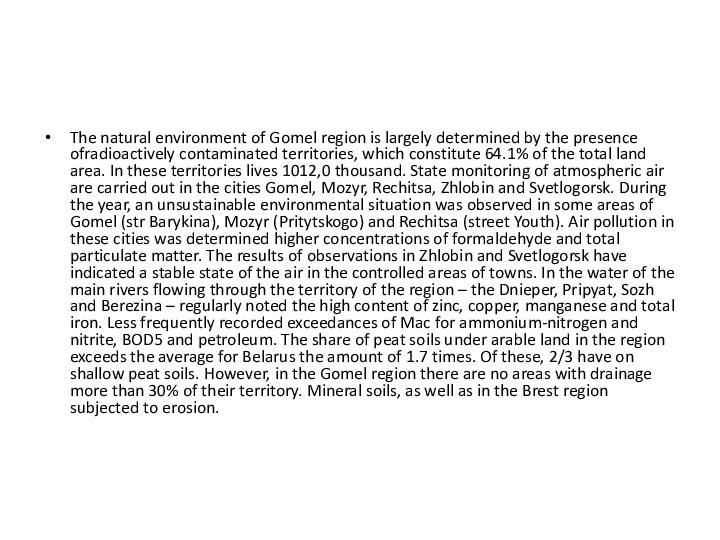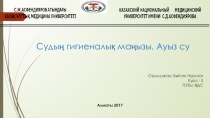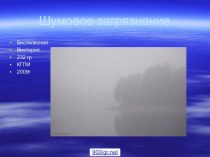Слайд 2
Environmental problems areas
Given a set of problems
is manifested differently in each of administrative regions of
the country. Regionally specific problems depends on natural and economic characteristics of the regions, as well as their position with respect to external sources of contaminants. Brest region is located mostly within the Polesie landscape province of the terraced alluvial, marsh and secondary water-glacial landscapes and partly Predpolesskaya province secondary water-glacial and moraine-outwash landscapes. Dominated by flat terrain with rocks of light mechanical composition is sandy and sandy loam and peat, which creates prerequisites for the development of deflationary processes. Shallow groundwater table is responsible for their low resistance to contamination.
Слайд 3
On the territory of the region are the

watersheds of the basins of three major rivers –
Pripyat, Western bug and Neman. Therefore, the river flowing here is not very large in size, and hence the resistance to contamination. The density of population of Brest region is 44 persons/km2, slightly below the average for the country indicator (47/km2). Rural population density – 15/km2, above the average (12 per km2). Zone of radioactive contamination in the Brest region occupies about 11% of the territory. Within its population of 140 thousand people. In the industrial structure is dominated by industries that do not have a high intensity impact on the natural environment – engineering and Metalworking, and food industry. However, quite a high proportion (over 7 percent) has electricity, which is characterized by high specific emissions and discharges of pollutants. State monitoring of atmospheric air is held in two cities: Brest and Pinsk. During the year, in Brest unstable environmental situation was observed in the 17 September, which recorded nearly 73% of exceeding the maximum single MPC in the city. In Pinsk most of the year, unfavorable environmental situation was observed in the area of the street.
Слайд 4
The problem of external effects is becoming
more important with increasing scale of production, and aggravation
of environmental problems.• External effects are costs or benefits from market transactions have not been reflected in the prices.• Negative external effects exacerbated the problem of environment. Serious problem in Belarus is the contamination of atmospheric air in cities and industrial centers of the Republic.Constant monitoring of condition of atmospheric air is established in 16 cities, which are home to more than 2/3 of the urban population of Belarus. In these industrial centres Goskomgidromet of the Republic of Belarus are monitoring at 50 stations, of which 3 – 4 times per day control over the contents of the 26 harmful substances. In the area of industrial enterprises, on highways and within residential areas the air quality is monitored by the centres of hygiene and epidemiology, Ministry of health of the Republic of Belarus.
Слайд 5
For the assessment of air quality uses

established by the Ministry of health standards of MPC
of pollutants and international standards recommended by the world health organization. The main sources of air pollution poses the greatest health threat is the increasing use of energy in the course of modernization of production, car exhaust, and some industrial products.• Measures to overcome the consequences of pollution include: introduction of standards on emissions; establishing emission fees, the creation of a market in pollution rights; sale on the market of temporary emission permits. Their goal is to reduce the emissions to an effective level and to improve the quality of the environment. The effective volume of emissions is characterized by the equality between the marginal social cost of pollution and marginal costs of reducing emissions.• Analyzing the dynamics of air quality in the city of Pinsk from 1985 to 2005. which is calculated for the five most common harmful substances (dust, sulphur dioxide, carbon monoxide, nitrogen dioxide and formaldehyde), taking into account their class of danger, quality standard and medium levels of air pollution., it may be noted that sulfur dioxide in 2005. compared to 1990 decreased by 1.4 MPC, however, the emissions of formaldehyde increased 3.12 times, which is associated with the increasing number of vehicles in the city.
Слайд 6
The average annual level of air pollution for
the city of Pinsk
Слайд 7
Thus, we can conclude that air pollution in
Pinsk low, because the total value of ISA for
over 20 years does not exceed 5.
Слайд 8
Brest region plays a critical role in the
conservation of biological diversity. Protected areas occupy 14.5% of
its total area, which is almost 2 times higher than the average for Belarus values. Here is the country's only facility-a natural monument world heritage national Park "Belovezhskaya Pushcha". Its territory extends partially in the Grodno region. Vitebsk region is located mainly within the province of lace-land, lake-glacial, moraine and hilly-moraine-lake landscapes. Features high ruggedness of the terrain and the district of lakes and a moderate level of agriculturaldevelopment. Drained by the Western Dvina river with its tributaries and partly by the Dnieper. Vitebsk oblast is the only region of Belarus, where radioactive contamination is virtually nonexistent. This circumstance, combined with the favourable natural properties of the site determines its high recreational potential.
Слайд 9
The density of the total population and the

rural population is the lowest in the country and
is respectively 32 and 9 people/km2. In the industrial complex stands out for the fuel industry, which produces more than half of all of the company's products. For a region characterized by the presence of large industrial facilities–sources of emissions of polluting substances. Almost 2/3 of their total volume accounted for emissions of Novopolotsk industrial hub, presented by the enterprises of power engineering, and chemical and petrochemical industry and 1/8 – emission city Novolukoml, which houses the thermal power plant. Located in Novopolotsk "Polimir" is one of the largest in Belarus chemically dangerous objects. Thus, the industrial hub of the city and acts as a source of potential environmental threats. For a region characterized by very large emissions of pollutants from stationary sources. It accounts for 31% of the total. Especially significant is the role of this region in sulfur dioxide emissions with 56% and non-methane volatile organic compounds and 47% of the total quantity of these substances emitted by stationary sources in the country. In Vitebsk region state monitoring of atmospheric air are carried out in the cities of Orsha, Polotsk, Novopolotsk and Vitebsk. Most of the year the air condition in certain districts of Vitebsk (lyudnikov Ave. and Kosmonavtov St.) and Orsha (Marx) was assessed as unsatisfactory. The main reason is the high level of formaldehyde emissions. In Polotsk and Novopolotsk unstable environmental conditions was observed only in the summer months. In the water of the Western Dvina in 68-98% of cases showed elevated levels of zinc, copper, total iron and manganese. The maximum permissible concentration for ammonia and nitrite were, respectively, 36 and 11%, BOD5 and oil – 4-5%. In Vitebsk region formed the lowest among administrative regions the number of waste production, which accounts for only 1.2% of the total. Agricultural lands occupy in the region of 40% of the territory, 1.1% lower than the national average value. Their distinctive feature is melacontrol. The average size of the contours of the farmland in the area about 2 times less than those in Belarus.
Слайд 10
The density of the total population and the

rural population is the lowest in the country and
is respectively 32 and 9 people/km2. In the industrial complex stands out for the fuel industry, which produces more than half of all of the company's products. For a region characterized by the presence of large industrial facilities–sources of emissions of polluting substances. Almost 2/3 of their total volume accounted for emissions of Novopolotsk industrial hub, presented by the enterprises of power engineering, and chemical and petrochemical industry and 1/8 – emission city Novolukoml, which houses the thermal power plant. Located in Novopolotsk "Polimir" is one of the largest in Belarus chemically dangerous objects. Thus, the industrial hub of the city and acts as a source of potential environmental threats. For a region characterized by very large emissions of pollutants from stationary sources. It accounts for 31% of the total. Especially significant is the role of this region in sulfur dioxide emissions with 56% and non-methane volatile organic compounds and 47% of the total quantity of these substances emitted by stationary sources in the country. In Vitebsk region state monitoring of atmospheric air are carried out in the cities of Orsha, Polotsk, Novopolotsk and Vitebsk. Most of the year the air condition in certain districts of Vitebsk (lyudnikov Ave. and Kosmonavtov St.) and Orsha (Marx) was assessed as unsatisfactory. The main reason is the high level of formaldehyde emissions. In Polotsk and Novopolotsk unstable environmental conditions was observed only in the summer months. In the water of the Western Dvina in 68-98% of cases showed elevated levels of zinc, copper, total iron and manganese. The maximum permissible concentration for ammonia and nitrite were, respectively, 36 and 11%, BOD5 and oil – 4-5%. In Vitebsk region formed the lowest among administrative regions the number of waste production, which accounts for only 1.2% of the total. Agricultural lands occupy in the region of 40% of the territory, 1.1% lower than the national average value. Their distinctive feature is melacontrol. The average size of the contours of the farmland in the area about 2 times less than those in Belarus.
Слайд 11
Currently, the JV "Pinskdrev-adriana" includes 4 stationary source
emissions of pollutants into the atmosphere. Allowed pollutant emissions
for 2009 amounted to 345,34 tons. From production at 184, 3 tons, from the boiler house of 161.3 tons.• The main source of emissions in the factory is part of the decorative parts lacquers and enamels. So in this area the spray booth is installed with strainers that capture eye-catching when spraying aerosols. Cleaning efficiency – 92%.•
Слайд 12
Limits of allowable emissions of pollutants into the
environment for 2007 - 2008 on the five natural
resources
Слайд 13
Overall, the average growth rate of permissible limits

of emissions by enterprises of Pinsk was 105%. Average
growth rate per year is 5% limits allowable emissions. Analyzing the data obtained, we can conclude that air pollution in the city of Pinsk in 2008. as compared to 2007. increased by 200 tons/year, which is associated with an increase in the number of businesses in the city.[2]• Based on conducted analysis it can be concluded that the limited availability of natural resources necessitates the increase of ecological requirements to the economy. Economic development itself is self-contradictory, since it generates, on the one hand, a number of environmental problems, and on the other it laid the basis for elimination of these contradictions. So you need a comprehensive solution to economic problems taking into account requirements of the natural environment and Vice versa. The confrontation between economy and ecology should be resolved in modern societies, not administration, and with the help of permanent institutions and mechanisms on the basis of market relations.
Слайд 14
In the region there has been a high

degree of soil erosion, which affects 10.7 per cent
of arable land. The negative effects of soil erosion in the Vitebsk region are especially notable because they relate not only to reduce their fertility, but also of pollution are numerous lakes. Challenges agricultural land use and relatively high avaloneast. So, in Vitebsk region pavlunina sixth part of the arable land. Gomel oblast. The natural conditions in Gomel oblast is similar to Brest. Both of them are located in the same provinces of landscape – woodland and Predpolessky. However, there are significant differences relating to the position of the areas in the river catchments. For the territory of Gomel region is not the dividing position, and the placement in the lower parts of the basins of such rivers of Belarus, Pripyat, Sozh and Berezina. The Dnieper drains an area of the region is its average current. Thus, the rivers here have a high water content, making them more resistant to external influences. The area boasts the highest degree of preservation of natural systems. Its forest cover is 45%, that in 1,2 times above the average (37.7 percent). The share of agricultural land here is the lowest in the country – 34%. The population density is also one of the lowest – 36 persons/km2. In the structure of industry a leading role is played by the fuel industry, ferrous metallurgy and machine building and Metalworking.
